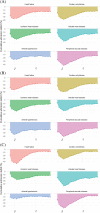Hospitalization deficit of in- and outpatient cases with cardiovascular diseases and utilization of cardiological interventions during the COVID-19 pandemic: Insights from the German-wide helios hospital network
- PMID: 33497509
- PMCID: PMC7943897
- DOI: 10.1002/clc.23549
Hospitalization deficit of in- and outpatient cases with cardiovascular diseases and utilization of cardiological interventions during the COVID-19 pandemic: Insights from the German-wide helios hospital network
Abstract
Background: Treatment numbers of various cardiovascular diseases were reduced throughout the early phase of the ongoing COVID-19 pandemic. Aim of this study was to (a) expand previous study periods to examine the long-term course of hospital admission numbers, (b) provide data for in- and outpatient care pathways, and (c) illustrate changes of numbers of cardiovascular procedures.
Methods and results: Administrative data of patients with ICD-10-encoded primary diagnoses of cardiovascular diseases (heart failure, cardiac arrhythmias, ischemic heart disease, valvular heart disease, hypertension, peripheral vascular disease) and in- or outpatient treatment between March, 13th 2020 and September, 10th 2020 were analyzed and compared with 2019 data. Numbers of cardiovascular procedures were calculated using OPS-codes. The cumulative hospital admission deficit (CumAD) was computed as the difference between expected and observed admissions for every week in 2020. In total, 80 hospitals contributed 294 361 patient cases to the database without relevant differences in baseline characteristics between the studied periods. There was a CumAD of -10% to -16% at the end of the study interval in 2020 for all disease groups driven to varying degrees by both reductions of in- and outpatient case numbers. The number of performed interventions was significantly reduced for all examined procedures (catheter ablations: -10%; cardiac electronic device implantations: -7%; percutaneous cardiovascular interventions: -9%; cardiovascular surgery: -15%).
Conclusions: This study provides data on the long-term development of cardiovascular patient care during the COVID-19 pandemic demonstrating a significant CumAD for several cardiovascular diseases and a concomitant performance deficit of cardiovascular interventions.
Keywords: COVID-19; SARS-CoV-2; cardiovascular hospitalizations; cardiovascular procedures.
© 2021 The Authors. Clinical Cardiology published by Wiley Periodicals LLC.
Conflict of interest statement
Gerhard Hindricks is receiving grants through the Leipzig Heart Institute from Boston Scientific (Boston Scientific Corporation, Marlborough, MA), and Abbott/St. Jude Medical (Abbott Laboratories, Chicago, IL), no personal payments are to declare. All other authors state that there is nothing to declare.
Figures



References
-
- Bollmann A, Hohenstein S, Meier‐Hellmann A, Kuhlen R, Hindricks G, Helios hospitals G . Emergency hospital admissions and interventional treatments for heart failure and cardiac arrhythmias in Germany during the Covid‐19 outbreak insights from the German‐wide Helios hospital network. Eur Heart J Qual Care Clin Outcomes. 2020;6(3):221‐222. 10.1093/ehjqcco/qcaa049. - DOI - PMC - PubMed
Publication types
MeSH terms
LinkOut - more resources
Full Text Sources
Other Literature Sources
Medical
Miscellaneous

